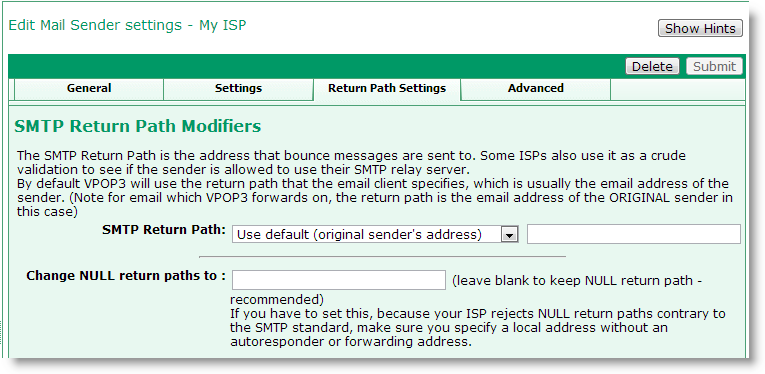

The Sender » Return Path Settings tab lets you set any automatic modifiers for the SMTP return path when sending mail using this Mail Sender.
In SMTP, the Return Path (or Return Address, or MAIL FROM address) is part of the SMTP envelope which is used to determine where bounce/delivery status messages will be sent. It is not the same as the 'Reply-to' address which is contained in the message header, and is where normal reply responses will be sent.
There are two modifications which VPOP3 can make to the Return Path
SMTP Return Path Modifiers
This option is most useful to deal with issues with forwarded messages. Normally if VPOP3 receives a message which it has to forward out itself, it will keep the original return path during forwarding. This can sometimes cause issues because:
•The original sender may be confused if they receive bounce messages for an email address they never used
•The Internet provider may reject the message because it appears to be from an address which is not one of their customers.
•An anti-forgery technology called SPF (Sender Policy Framework) may cause the messages to be rejected because they are coming from a mail server which is not approved by the return path's domain
The SMTP Return Path modifier has three options
•Use default - VPOP3 leaves the return path as it was originally. No changes
•Always Set to: - VPOP3 will always set the return path to the specified email address. The specified email address will receive all bounce messages & delivery status reports.
•If the original address is not local, set to: - VPOP3 will leave the return path as it is as long as it is a local email address. If the return path is not local, then VPOP3 will change it to be the specified email address. The original local users will receive bounce messages & delivery status reports for messages they send, but for forwarded messages, any such messages will be sent to the specified email address.
For problems with forwarding email, you would normally use the If the original address is not local option.
Remember that changing the return path using this setting will not change where any replies to the messages are sent.
Note that changing the return path in this way may not solve email forwarding problems if your Internet provider checks other things other than the SMTP return path - e.g. if they check the From or Reply-To header fields. In this case there is realistically nothing that VPOP3 can do to make forwarding work through your Internet provider's mail server. You may need to use a third party SMTP relay service, or have users collect their mail directly from VPOP3, instead of using mail forwarding.
Null Return Paths
The Change NULL return paths to option lets you tell VPOP3 to use a specific return path address if it would otherwise use a blank return path.
In the SMTP standards, a blank return path is explicitly allowed, and has a specific meaning - which is to indicate that bounce messages should not be generated if a message cannot be delivered. This is extremely useful for automated messages, such as other bounce messages, or automated responses, because it prevents the creation of mail loops where two servers will endlessly send bounce messages between each other.
Unfortunately, some Internet providers have badly configured mail servers which prevent you using a blank return path. In this case, you can tell VPOP3 to change the return path to be a specific email address. The email address should be an email address on your domain which will never have any forwarding set, or any autoresponders. For example, you could create a distribution list called 'no-reply' with no members and set this setting to no-reply@yourdomain.com.
If you do accidentally set VPOP3 to change null return paths to an email address with forwarding on, you could create a mail loop where messages are bounced between two servers endlessly. Changing this setting to a suitable email address instead should stop the loop from continuing.
